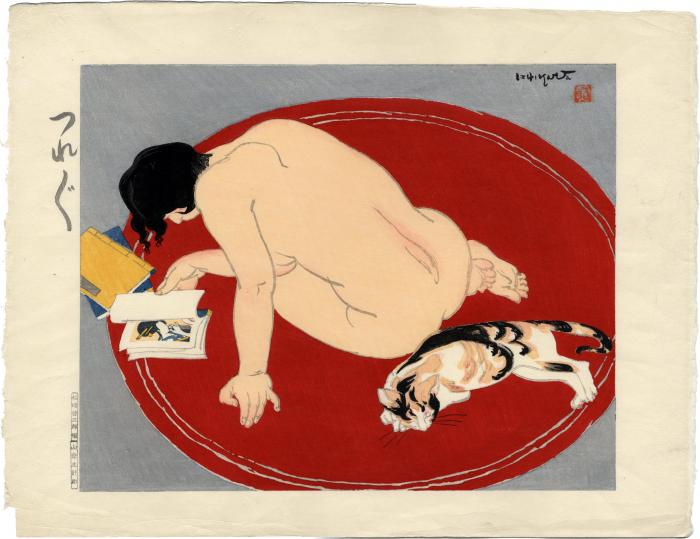Ishikawa Toraji (石川寅治) (artist 1875 – 1964)
Bored (Tsurezure - つれづれ) from the series Ten Types of Female Nudes: Rajo jūsshu - 裸女十種)
1935
14.75 in x 19 in (Overall dimensions) Japanese woodblock print
Signed: Ishikawa
Carver: Yamagishi Kazue to
British Museum
Achenbach Foundation
Hamilton Art Gallery, Australia
National Diet Library - photo in black and white of this print
Art Institute of Chicago
National Gallery of Victoria - all ten prints from this set are illustrated at this link
Museum für angewandte Kunst, Vienna
Brooklyn Museum
Nihon no hanga "One of the most celebrated and controversial series of prints of this dynamic era is Toraji Ishikawa’s Ten nudes. In 1934, at the age of fifty-four, he collaborated with the woodblock carver Yamagishi Kazue to self-publish a series of deluxe polychrome large-format prints featuring graduating colours and glistening mica backgrounds. Toraji’s tour de force, Ten nudes depicts Japanese women in fashionable 1930s lounge room and bathroom interiors that are decorated with Art Deco furniture, fabrics, rugs, curtains, wallpaper, tiles and fittings. The figurative style is influenced by his travels and studies in Europe, and the prints feature voluptuous nudes sporting soft permed waves, plaits, ponytails or chic bob hairstyles that were favoured by modern Japanese women of the time. In the tradition of ukiyo-e bijin prints (prints of beauties), these contemporary women are captured at private moments in the seclusion of intimate home settings, playing with pets, reading a book or bathing. Their natural, languid poses are accompanied by accessories of pleasure and leisure in the form of stretching cats, a fluffy Pekingese dog, a scattering of mah-jong tiles, a quintessential 1930s blue parrot, and in one case a woman looking at a book of historical woodblock prints that can be interpreted as the artist linking himself to the tradition of ukiyo-e.
The tenth print in the series, and the most risqué, Dance evocatively depicts a stripper illuminated by stage light, in high heels, with a far from modest netted shawl. This famous print is indicative of the freewheeling era and a scene that may have been found at small night club in the back streets of Ginza or in numerous other entertainment districts of 1930s Tokyo.
Due to the series’ sensual and explicit nature and its release being made during times of growing political authoritarianism, police attempted to ban the series at the time of its release and Toraji only produced one further single sheet nude print in 1936. In contrast to these hedonistic works, Toraji became a war artist from 1938 to 1943 and documented Japan’s expansion throughout the Asia-Pacific region with sketches, paintings and even two large canvases depicting Japanese air victories over American planes. After the war Toraji remained active to his death in 1964, producing oil paintings primarily of Japanese coastal landscape, but never achieved again the finesse, notoriety and controversy of his hallmark Ten nudes series from 1934."
Wayne Crothers, Curator, Asian Art, National Gallery of Victoria (in 2015)
****
Illustrated:
1) In The Female Image: 20th Century Prints of Japanese Beauties by Amy Newland and S. Hamanaka, Leiden, Hotei, 2000, pg. 174, pl. 244.
2) In black and white in 近代日本美人画展 : 伝統木版画を支えた作家たち Exhibition of Modern Japanese Beauties: Meiji, Taishō, Shōwa, Riccar Art Museum, 1982, n.p., no. 73.
3) In a full-page color reproduction in The Japanese Print Since 1900: Old Dreams and New Visions by Lawrence Smith, Harper Collins Publishers, 1983, p. 75.
modern prints (shin hanga - 新版画) (genre)
